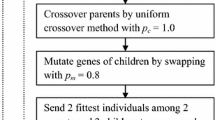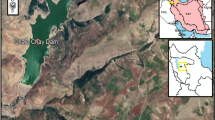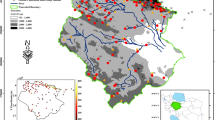Abstract
In many studies of water and hydrological sources, estimation of the spatial distribution of precipitation based on point data recorded in rain gauge stations is of particular importance. The purpose of this paper is to optimize the network of rain gauge stations in the Sistan and Baluchestan Province with respect to the variance of Kriging and topography estimation in the region and to maintain or reduce the number of stations in the region (without incurring additional costs). A new neural network algorithm has been presented in the present study to determine the optimum rain gauge stations. In this study, a new method of meta-heuristic optimization algorithm based on biological neural systems and artificial neural networks (ANNs) has been proposed. The proposed method is called a neural network algorithm (NNA) and has been developed based on unique structure (ANNs). In order to evaluate the proposed method, the election and whale algorithms have been used. The election algorithm is a repetitive algorithm that works with a set of known solutions as a population, and the whale optimization algorithm is derived from the new nature based on the special bubble hunting strategy used by the vultures. The results showed that 22 stations of the existing network had no significant effect on rainfall estimation in the province and their removal to the optimal network is suggested. Therefore, the remaining 27 stations can be effective in optimizing the rain gauge network. The results of comparing the abovementioned algorithms showed that the neural network algorithm with a mean error of 0.06 mm has a higher ability to optimize the rain gauges than blue whale and election algorithms.










Similar content being viewed by others
References
Adhikary, S. K., Yilmaz, A. G., & Muttil, N. (2014). Optimal design of rain gauge network in the Middle Yarra River catchment, Australia. Hydrologycal Processes, 29(3), 2582–2599.
Al-Aboodi, A. H. D., & Al-Abadi, A. M. (2014). Optimum rain-gauges network design of some cities in Iraq. Journal of University of Babylon, 22(4), 938–950.
Bayat, B., Hosseini, K., Nasseri, M., & Karami, H. (2019). Challenge of rainfall network design considering spatial versus spatiotemporal variations. Journal of Hydrology, 2019.
Bazrafshan A. Zahra Gerkani Nezhad Moshizi, Teymuri F. (2017). Optimization of the number of rain gauge stations in Iran based on the interpolation methods and principal component analysis. 4 (3), 910-897. (In Persian)
Chebbi, A., Bargaoui, Z. K., & da Conceição Cunha, M. (2013). Development of a method of robust rain gauge network optimization based on intensity-duration-frequency results. Hydrology and Earth System Sciences, 17, 4259–4268.
Cheng, K. S., Wei, C., Cheng, Y. B., Yeh, H. C., & Liou, J. J. (2008). Rain-gauge network evaluation and augmentation using geostatistics. Hydrological Processes: An International Journal, 22(14), 2555–2564.
Cressie, N. A. C. (1991). Statistics for spatial data. John Wiley & Sons.
Delmelle, E. M. (2014). Spatial sampling. Handbook of Regional Science, 1385–1399.
Delmelle, E. M., & Goovaerts, P. (2009). Second-phase sampling designs for non-stationary spatial variables. Geoderma, 153(1-2), 205–216.
Emami, H., & Derakhshan, F. (2015). Election algorithm: A new socio-politically inspired strategy. AI Communications, 28(3), 591–603.
Faraji Sabokbar, H., Mahmoudi Meimand, H., Nazif, S., & Ali Abbaspour, R. (1393). Optimal development of rainwater-grid measurement using Kriging and entropy in the environment (case study: Karkheh Basin). Natural Geography Research, 46(4), 445–462.
Feki, H., Slimani, M., & Cudennec, C. H. (2016). Geostatistically based optimization of a rainfall monitoring network extension: Case of the climatically heterogeneous Tunisia. Hydrology Research, 2016, 48(1).
Goldbogen, J. A., Friedlaender, A. S., Calambokidis, J., Mckenna, M. F., Simon, M., & Nowacek, D. P. (2013). Integrative approaches to the study of baleen whale diving behavior, feeding performance, and foraging ecology. BioScience, 63, 90–100.
Goovaerts, P. (1997). Geostatistics for natural resource evaluation (pp. 312–318). New York: Oxford University.
Hasani Pak, A. A. (2001). Geostatistics. Tehran: Tehran University Press.
Hasani Pak, A. A. (2007). Exploratory data analysis. Tehran: Tehran University Press.
Hassoun, M. H. (1995). Fundamentals of artificial neural networks. Campridge: The MIT Press.
Hof, P. R., & Van Der Gucht, E. (2007). Structure of the cerebral cortex of the humpback whale, Megaptera novaeangliae (Cetacea, Mysticeti, Balaenopteridae). The Anatomical Record, 290, 1–31.
Jafarzadeh, A., & Khashei-Siuki, A. (2018). Performance examination of optimization model of groundwater monitoring network based on gray wolf and neural network (GNM) (case study: Birjand plain). Iranian Journal of Irrigation and Water Engineering., 8(3), 121–139.
Kassim, A. H. M., & Kottegoda, N. T. (1991). Rainfall network design through comparative Kriging methods. Hydrological Sciences Journal, 36, 223–240.
Kavusi, M., KHashei Siuki, A., & Dastourani, M. (2020). Optimal design of groundwater monitoring network using the combined Election-Kriging method. Water Resources Management: An International Journal, Published for the European Water Resources Association (EWRA), 1–14.
Khashei Siuki, A., Ghahraman, B., & Kouchakzadeh, M. (2013). Comparison of ANN, ANFIS and regression models to estimate groundwater level of neyshaboor aquifer. Iranian Journal of lrrigation and Drainage, 7, Spring 2013(1), 10–22.
Mirjalili, S., & Lewis, A. (2016). The whale optimization algorithm. Advances in Engineering Software, 95, 51–67.
Mirzaei-Nodoushan, F., Bozorg Haddad, O., & Khayyat Kholghi, M. (2016). Two-objective design of groundwater-level monitoring network using NSGA-II in Eshtehard plain. Iranian Journal of Soil and Water Research, 47(2), 345–354. https://doi.org/10.22059/ijswr.2016.58339.
Mishra, A. K., & Coulibaly, P. (2009). Developments in hydrometric network design: A review. Reviews of Geophysics, 47, RG2001.
Mohammadi, M., Karami, H., Farzin, S., & Farokhi, A. (2017). Prediction of monthly precipitation based on large-scale climate signals using intelligent models and multiple linear regression (case study: Semnan Synoptic Station). The Univercity of Tehrans Scientific Journals Database., 4(1), 201–214 (In Persian).
Mohd Aziz, M., Yusof, F., Mohd Daud, Z., Yusop, A., & Afif, M. (2016). Optimal design of rain gauge network in Johor by using geostatistics and particle swarm optimization. International Journal of GEOMATE, 11(25), 2422–2428.
Mokhtari, D., Zandkarimi, A., & Zandkarimi, S. (2016). Application of geostatistical methods to optimize and strengthen the network of rainfall stations in Kurdistan province to increase the accuracy of hydrological modeling. Hydrogeomorphology, 8, 72–53.
Moreira, D. C., & Nunes, L. C. (2014). Experimental analysis of bonded single lap joint with flexible adhesive. Applied Adhesion Science, 2(1), 1.
Nazaripour, H., & Daneshvar, M. R. M. (2017). Rain gauge network evaluation and optimal design using spatial correlation approach in arid and semi-arid regions of Iran. Theoretical and Applied Climatology, 129(3-4), 1255–1261.
Nazeri Tahroudi, M., Khashei Siuki, A., & Ramezani, Y. (2019). Redesigning and monitoring groundwater quality and quantity networks by using the entropy theory. Environmental Monitoring and Assessment, 191(2019), 250.
Pourreza Bailandi, M., Shafiei, M., Shahabi Fard, F., & Zadeh, H. M. (2018). Application of acceptance probability approach to determination of optimal density of rainfall stations in South Khorasan province. Journal of Agricultural Meteorology, 1, 18–18.
Ramazanifar, M. (2018). Evaluation and optimization of rainguage stations network based on probabilistic Kriging method (case study: Razavi and South Khorasan Provinces). Master of Science in Water Engineering: Mashhad Ferdowsi University.
Rodriguez Iturbe, I., & Mejía, J. M. (1974). The design of rainfall networks in time and space. Water Resources Research, 10(4), 713–728.
Rojas, R. (1996). Neural Networks. Berlin: Springer-Verlag.
Sadollah, A., Sayyaadi, H., & Yadav, A. (2018). A dynamic metaheuristic optimization model inspired by biological nervous systems: Neural network algorithm. Applied Soft Computing, 71, 747–782.
Shafiee, M., Ghahreman, B., & Saghafian, B. (2013). Evaluation and optimization of rainwater stations network based on possible Kriging method (case study: Gorgan River Basin). Iranian Water Resources Research, Ninth Year, No., 2, 18–19.
Smith, K. A. (1999). Neural networks for combinatorial optimization: A review onmore than a decade of research. INFORMS Journal on Computing, 11, 15–34.
Watkins, W. A., & Schevill, W. E. (1979). Aerial observation of feeding behavior in four baleen whales: Eubalaena glacialis, Balaenoptera borealis, Megaptera novaean- gliae, and Balaenoptera physalus. Journal of Mammalogy, 60, 155–163.
Xie, Y., Bin Chen, T., Lei, M., Yang, J., Guo, Q.-j., Song, B., & Zhou, X.-y. (2011). Spatial distribution of soil heavy metal pollution estimated by different interpolation methods: Accuracy and uncertainty analysis. Chemosphere, 82(3), 468–476.
Yeh, H. C., Chen, Y. C., Wei, C., & Ru-Huei, C. (2011). Entropy and Kriging approach to rainfall network design. Paddy and Water Environment, 9, 343–355.
Yousefi, H., Nohegar, A., Khosravi, Z., & Azizabadi, F. M. (2015). Drought modeling and management using SPI and RDI indexes (Case study: Markazi provin). The University of Tehrans Scientific Journals Database., 2(3), 337–344 (In Persian).
Zurada, J. M. (1992). Introduction to artificial neural systems. New York: West Publishing Co..
Acknowledgements
This work was supported by the University of Birjand. We would also like to extend our thanks to the Research Deputy of the University of Birjand for their help in offering our resources in running the program.
Author information
Authors and Affiliations
Corresponding author
Additional information
Publisher’s note
Springer Nature remains neutral with regard to jurisdictional claims in published maps and institutional affiliations.
Rights and permissions
About this article
Cite this article
Safavi, M., Siuki, A.K. & Hashemi, S.R. New optimization methods for designing rain stations network using new neural network, election, and whale optimization algorithms by combining the Kriging method. Environ Monit Assess 193, 4 (2021). https://doi.org/10.1007/s10661-020-08726-z
Received:
Accepted:
Published:
DOI: https://doi.org/10.1007/s10661-020-08726-z




